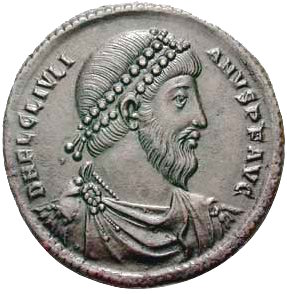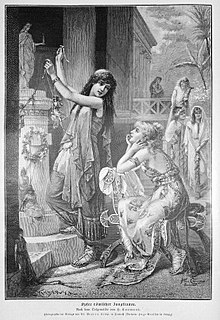
Julian was Roman emperor from 361 to 363, as well as a notable philosopher and author in Greek. His rejection of Christianity, and his promotion of Neoplatonic Hellenism in its place, caused him to be remembered as Julian the Apostate in Christian tradition.

Lupercalia was a pastoral festival of Ancient Rome observed annually on February 15 to purify the city, promoting health and fertility. Lupercalia was also known as dies Februatus, after the purification instruments called februa, the basis for the month named Februarius.

Paganism is a term first used in the fourth century by early Christians for people in the Roman Empire who practiced polytheism or ethnic religions other than Judaism. In the time of the Roman empire, individuals fell into the pagan class either because they were increasingly rural and provincial relative to the Christian population, or because they were not milites Christi. Alternative terms in Christian texts were hellene, gentile, and heathen. Ritual sacrifice was an integral part of ancient Graeco-Roman religion and was regarded as an indication of whether a person was pagan or Christian. Paganism has broadly connoted the "religion of the peasantry".

Mystery religions, mystery cults, sacred mysteries or simply mysteries, were religious schools of the Greco-Roman world for which participation was reserved to initiates (mystai). The main characterization of this religion is the secrecy associated with the particulars of the initiation and the ritual practice, which may not be revealed to outsiders. The most famous mysteries of Greco-Roman antiquity were the Eleusinian Mysteries, which were of considerable antiquity and predated the Greek Dark Ages. The mystery schools flourished in Late Antiquity; Julian the Apostate in the mid 4th century is known to have been initiated into three distinct mystery schools—most notably the mithraists. Due to the secret nature of the school, and because the mystery religions of Late Antiquity were persecuted by the Christian Roman Empire from the 4th century, the details of these religious practices are derived from descriptions, imagery and cross-cultural studies. Much information on the Mysteries come from Marcus Terentius Varro.

Hellenism (Ἑλληνισμός) represents the totality of Hellenic culture; understood as a "body of humanistic and classical ideals associated with ancient Greece" as well as "the language, culture, and values of the Greeks." Furthermore, in a religious context, it refers to the modern pluralistic and orthopraxic religion derived from the beliefs, mythology and rituals of the ancient Greeks, also going by the name of Dodekatheism (Δωδεκαθεϊσμός). It is a system of thought and spirituality with a shared culture and ethos, and common ritualistic, linguistic and literary tradition. More broadly, Hellenism centers itself around the worship of Hellenic deities, namely the twelve Olympians.

Ancient Greek religion encompasses the collection of beliefs, rituals, and mythology originating in ancient Greece in the form of both popular public religion and cult practices. The application of the modern concept of “religion” to ancient cultures has been questioned as anachronistic. The ancient Greeks did not have a word for 'religion' in the modern sense. Likewise, no Greek writer known to us classifies either the gods or the cult practices into separate 'religions'. Instead, for example, Herodotus speaks of the Hellenes as having "common shrines of the gods and sacrifices, and the same kinds of customs."

On the city of God against the pagans, often called The City of God, is a book of Christian philosophy written in Latin by Augustine of Hippo in the early 5th century AD. The book was in response to allegations that Christianity brought about the decline of Rome and is considered one of Augustine's most important works, standing alongside The Confessions, The Enchiridion, On Christian Doctrine, and On the Trinity. As a work of one of the most influential Church Fathers, The City of God is a cornerstone of Western thought, expounding on many profound questions of theology, such as the suffering of the righteous, the existence of evil, the conflict between free will and divine omniscience, and the doctrine of original sin.

In Roman religion, Terminus was the god who protected boundary markers; his name was the Latin word for such a marker. Sacrifices were performed to sanctify each boundary stone, and landowners celebrated a festival called the "Terminalia" in Terminus' honor each year on February 23. The Temple of Jupiter Optimus Maximus on the Capitoline Hill was thought to have been built over a shrine to Terminus, and he was occasionally identified as an aspect of Jupiter under the name "Jupiter Terminalis".

Germanic paganism refers to the various religious practices of the Germanic peoples from the Iron Age until Christianisation during the Middle Ages. Religious practices represented an essential element of early Germanic culture. From both archaeological remains and literary sources, it is possible to trace a number of common or closely related beliefs among the Germanic peoples into the Middle Ages, when the last areas in Scandinavia were Christianized. Rooted in Proto-Indo-European religion, Proto-Germanic religion expanded during the Migration Period, yielding extensions such as Old Norse religion among the North Germanic peoples, the paganism practiced amid the continental Germanic peoples, and Anglo-Saxon paganism among the Old English-speaking peoples. The Germanic religion is best documented in 10th- and 11th-century texts from Scandinavia and Iceland.
In ancient Roman religion, the Armilustrium was a festival in honor of Mars, the god of war, celebrated on October 19. On this day the weapons of the soldiers were ritually purified and stored for winter. The army would be assembled and reviewed in the Circus Maximus, garlanded with flowers. The trumpets (tubae) would be played as part of the purification rites. The Romans gathered with their arms and armour on the Aventine Hill, and held a procession with torches and sacrificial animals. The dancing priests of Mars known as the Salii may also have taken part in the ceremony.

Ancient Celtic religion, commonly known as Celtic paganism, comprises the religious beliefs and practices adhered to by the Iron Age people of Western Europe now known as the Celts, roughly between 500 BCE and 500 CE, spanning the La Tène period and the Roman era, and in the case of the Insular Celts the British and Irish Iron Age. Very little is known with any certainty about the subject, and apart from documented names, which are thought to be of deities, the only detailed contemporary accounts are by hostile Roman writers, who were probably not well-informed.

A buccina or bucina, anglicized buccin or bucine, is a brass instrument that was used in the ancient Roman army, similar to the cornu. An aeneator who blew a buccina was called a "buccinator" or "bucinator".
The music of ancient Greece was almost universally present in ancient Greek society, from marriages, funerals, and religious ceremonies to theatre, folk music, and the ballad-like reciting of epic poetry. It thus played an integral role in the lives of ancient Greeks. There are some fragments of actual Greek musical notation, many literary references, depictions on ceramics and relvent archaeological remains, such that some things can be known—or reasonably surmised—about what the music sounded like, the general role of music in society, the economics of music, the importance of a professional caste of musicians, etc.

Against Celsus, preserved entirely in Greek, is a major apologetics work by the Church Father Origen of Alexandria, written in around 248 AD, countering the writings of Celsus, a pagan philosopher and controversialist who had written a scathing attack on Christianity in his treatise Logos Alēthēs. Among a variety of other charges, Celsus had denounced many Christian doctrines as irrational and criticized Christians themselves as uneducated, deluded, unpatriotic, close-minded towards reason, and too accepting of sinners. He had accused Jesus of performing his miracles using black magic rather than actual divine powers and of plagiarizing his teachings from Plato. Celsus had warned that Christianity itself was drawing people away from traditional religion and claimed that its growth would lead to a collapse of traditional, conservative values.

The decline of Greco-Roman polytheism, also sometimes referred to as the decline of paganism in the Roman Empire, according to a long established theory, began as a slow process in the second to first century BC, then sped up dramatically in the fourth century AD, producing paganism's catastrophic collapse in the fifth century AD. Both the slow decline of paganism, and the catastrophic demise of paganism afterwards in Late Antiquity, became disputed in the late twentieth century. Modern scholarship sees the traditional public cults as remaining vibrantly alive throughout the Hellenistic era and on into the period of empire. Defining Late Antiquity by its social, cultural and religious themes has allowed that period to be seen as a period of creative change, rather than decline, that lasted into the seventh century. In debates over the nature of Late Antiquity, a political model still champions the view of rupture, whereas a religious theme insists this process was a metamorphosis with a basic continuity rather than drastic collapse. People moved from "religion embedded in the city-state" to "religion as a choice".

Paganism is commonly used to refer to various religions that existed during Antiquity and the Middle Ages, such as the Greco-Roman religions of the Roman Empire, including the Roman imperial cult, the various mystery religions, religions such as Neoplatonism and Gnosticism, and more localized ethnic religions practiced both inside and outside the Empire. During the Middle Ages, the term was also adapted to refer to religions practiced outside the former Roman Empire, such as Germanic paganism, Egyptian paganism and Baltic paganism.

The persecution of Christians occurred throughout most of the Roman Empire's history, beginning in the 1st century AD. Originally a polytheistic empire in the traditions of Roman paganism and the Hellenistic religion, as Christianity spread through the empire, it came into ideological conflict with the imperial cult of ancient Rome. Pagan practices such as making sacrifices to the deified emperors or other gods were abhorrent to Christians as their beliefs prohibited idolatry. The state and other members of civic society punished Christians for treason, various rumored crimes, illegal assembly, and for introducing an alien cult that led to Roman apostasy.
In ancient Roman religion, the Fordicidia was a festival of fertility, held two days after the Ides of April, that pertained to farming and animal husbandry. It involved the sacrifice of a pregnant cow to Tellus, the ancient Roman goddess of the Earth, in proximity to the festival of Ceres (Cerealia) on April 19.

Persecution of pagans in the late Roman Empire began during the reign of Constantine the Great (306–337) in the military colony of Aelia Capitolina (Jerusalem), when he destroyed a pagan temple for the purpose of constructing a Christian church. Christian historians alleged that Hadrian had constructed a temple to Aphrodite on the site of the crucifixion of Jesus on Golgotha hill in order to suppress Jewish Christian veneration there. Constantine used that to justify the temple's destruction, saying he was simply reclaiming the property.

Interpretatio christiana is adaptation of non-Christian elements of culture or historical facts to the worldview of Christianity. The term is commonly applied to recasting of religious and cultural activities, beliefs and imageries of "pagan" peoples into a Christianized form as a strategy for Christianization. From a Christian perspective, "pagan" refers to the various religious beliefs and practices of those who adhered to non-Abrahamic faiths, including within the Greco-Roman world the traditional public and domestic religion of ancient Rome, imperial cult, Hellenistic religion, the ancient Egyptian religion, Celtic and Germanic polytheism, initiation religions such as the Eleusinian Mysteries and Mithraism, the religions of the ancient Near East, and the Punic religion.


















